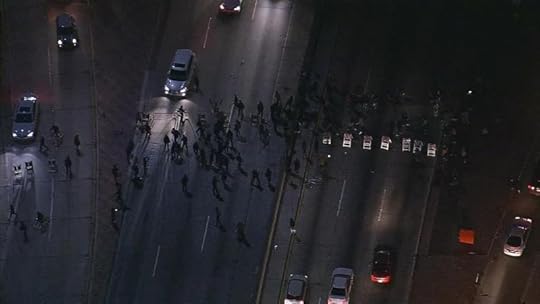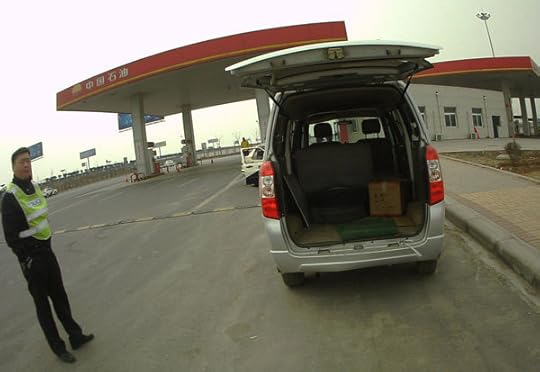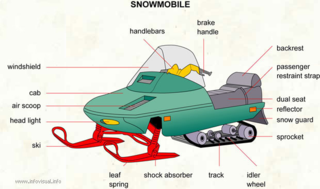John Robb's Blog, page 15
January 2, 2015
GG Update - January 2, 2015
Some items of interest:
The random darknet shopper. A bot with a budget to randomly purchase items on darknet sites. It had a budget of $100 in bitcoins to spend every week. Here's what it bought. BTW, the law is fairly squishy on bots that break the law. Here's a Hungarian passport it bought. --> This is an automated way to grief a specific individual (CEO, Judge, etc.).

Nanodegrees. An attempt by Udacity to unbundle education so that you can learn just what you need. This would only be of value if going to college was about education. It's not. Innovation like this might be possible within new economic networks (likely tied together by blockchains to prevent spoofing/scams).
Swatting. Is there an upside to the militarization of the US police system? There is if you want to attack a person using something called swatting. Swatting is a fake call to 911 that prompts the police to send SWAT to take down the target's address. Swatting has been around for a looong while but it's only recently become a national epidemic (we don't now how bad it is because the FBI doesn't track statistics on it = who could have guessed that?).
Stampedes. Crowds are more likely to turn deadly when trying to enter a venue than exit it. Why? One reason is that entry is often restricted to collect tickets/etc or control timing (think Walmart on black Friday). Exit options are often more fluid and open. Another reason is that crowds often surge forward when there's reason to believe they are missing an opportunity (as we saw in the Shanghai stampede on new years night that killed 36 people).

.... Art vs. ISIS

December 27, 2014
Lawfare vs. Uber
The number of lawsuits and police raids aimed at Uber is pretty amazing.
Here's a smattering of the lawfare being waged against Uber (there are many, many others):
Class action law suit against Uber over its "safety fee" seeking the return of the fee to all customers it has charged for it.
Violation of consumer protection laws. DAs in LA and SF. Seeking fines + change in behavior.
Violating India's financial laws by using an overseas payment mechanism. India bans uber, drivers face fines.
Uber and its CEO for operating illegal car service. Seoul bans Uber.
France will ban Uber in 2015.
Uber banned in Spain.
Taiwan fines Uber and is seeking to ban it.
Nevada banned Uber across the state. The company is attempting to crowdsource support to overturn it.
Uber driver training class.
I suspect that Uber would have enough support from driver "partners" to push through this resistance if most of them weren't making min wage or less (even though they take all of the economic risk by supplying the car and the labor). It would also get more support if the company was actually a "peering or sharing" system (where customers and drivers connect) rather than an Internet taxi service (a standard company that owns the customer relationship and treats and crowdsources its cars and driving).
JR
PS: I call companies based on what Uber does, turking companies. An Internet turking company uses the following to expand into traditional industries:
Internet economics -- from global access to customers and workers via smartphones to massive economies of scale that drive costs down.
An assemblyline managed by a smart phone app. This is new. It's Taylorism reworked for services. Workers micro-managed as if they were "bots." It also sets the stage for rapid 'botification' of work.
Independent contractors who supply both capital (cars) and labor (driving) -- they take all of the risk.
IN the not too distant future, we may see a global turking company "employ" over a billion people.
December 23, 2014
Here's How A Global Insurgency Can Take Down Uber
is a turking company. Its business model is based on turning people into bots.
How does it do that?
It uses a smart phone app to turn independent contractors into driving bots (drones). Drones are people who do the simple tasks the Uber app tells them to do.
Breaking down tasks this way makes it easier for turking companies like Uber to get big quickly and go global early. It will also (incidently) make it easier for the company to replace these contractor partners with bots when the bots becomes sophisticated enough to replace them in the next decade.
So far, the formula has worked well. Uber now sports a $40 billion valuation and climbing. This suggests that if Uber continues on its path to success, we're going to see app-driven turking companies turning contractors into subsistence income bots in nearly every industry, from medicine to education.
Early on, the only opposition to Uber was from taxi companies and local city councils (largely corrupt). More recently, opposition to Uber has formed over several high profile sexual assaults in India and Boston. These assaults have created a small open source insurgency that is fighting an open source media war against Uber from Taiwan to India to Paris to Seattle.
What's interesting to me is how the insurgency has stumbled upon a systempunkt -- the point of greatest weakness to attack -- that is valid for nearly all of the early turking companies:
Uber's drivers aren't the faceless, nameless bots customers expect them to be. They are real people with equally real flaws.
Turking companies expect to be able to hire people that act like nameless, faceless bots -- quickly, easily and at low cost. That is proving impossible in the near term, and these assaults are the result.
This flaw makes Uber very vulnerable to disruption from an open source insurgency. How so? It makes it possible for independent groups to attack the company's brand whenever the following occurs:
Sexual assault (many instances).
Road rage.
Sexual harrassment or verbal abuse.
Theft (Customer: driver demands $500 for phone left in car --> Uber: we deactivated "the driver's account" until he returns your phone).
To defend itself from these attacks, Uber is spending tens of millions on PR firms, phalanxes of lobbyists in Washington and capitals around the world. However, this defense won't work if the brand is damaged and its funding is sidetracked.
Will this systempunkt be sufficient to bring down the brand of the world's first turking company (and thereby slowing down the rise of turking)?
I'm not sure. It would require:
Moral warfare waged against the brand that pits customers against the company and the drivers against he company.
Attrition warfare waged against Uber's income with the goal of causing the company to miss a quarter (grow less than expected). The company is particularly vulnerable during its ramp.
Maneuver warfare that creates fear, uncertainty, and doubt through attacks from unusual quaters. Law suits and legal action that put hair on the offering. Physical attacks/disruption by outside groups that puts drivers and customers at risk.
December 22, 2014
Why the Sony Hack Worked
The Sony hack worked. It did the job it was intended to do. It coerced a major corporation and its corporate partners into changing their behavior.
It's a good example of a type of attack we are going to see much more of.
However, it's important to understand why it worked so well. It wasn't due to:
its sophistication,
the damage it did to Sony's critical systems, or
the amount of money it stole.
It was effective because it went after employees and business partners as individuals.
It was effective because it pierced the corporate veil by personally attacking every employee at Sony (and some of their business partners).
The corporate veil is a fictive barrier that protects employees, as individuals, from what they do as employees for the corporations they work for. While the veil is primarily used as a legal term (when determining liability for example), it's also useful in thinking about what happens when corporations go to war.
How to Pierce the Corporate Veil
Gather Information: The hack didn't just pierce the veil selectively (as it could have by spear phishing), it shattered it by gobbling up personal detail on every employee. This data included everything from:
Financial and benefit accounts - to -
E-mails depicting conversational exchanges - to -
Health information and other details from personnel files.
Amplify the information: In this hack, they released the data. Selectively and slowly, in the very same way Snowden released the NSA's data.
Slow is better, because it keeps the attack in the press. Naturally, the "viral press" (from Gawker to Huffington Post to Business Insider) pounced on it like red meat.
Within days, there were dozens of stringers at these orgs spending their days and nights sifting through the Sony files to find juicy headlines to publish.
Use the Hack as a Moral attack on the Company:
The first moral level attack was aimed at Sony's senior management separating them from their business partners (producers and talent). It worked.
The second attack was aimed at shattering the moral cohesion of the company by separating management from employees. The company did quite a bit of this to themselves by mishandled the entire situation -- they kept their employees in the dark while their personal data was in the wind.
At the employee level, it was a mess. Here's a couple of examples:
My bank account was hacked [on the day of the first attack,]” said our source who works at SPE offices in Los Angeles. “At first we just thought it was total coincidence.”
-or-
I was completely irate. Once it got personal, it was just, are you kidding me? Seeing the faces of colleagues with families—they’re worried about their life savings, their retirement funds, their kids.
What was the effect of this attack on employees? It shattered the moral cohesion of Sony as a company. The proof of this is that Sony is now facing not one, but three class action law suits from its own employees.
December 18, 2014
Corporate Disruption using Snowden Style Moral Warfare
In light of he Sony hack, here's some earlier GG thinking on disrupting corporations.
Piercing the corporate veil.
Targeting corporations.
Corporate psychology.
The most interesting aspect of the Sony hack?
As we anticipated, nobody cared. Not the public. Not the government.
In fact, most people made fun of the victims and the information released was widely reprinted.
Why did wasn't there a response? Three reasons:
the attack was bloodless and it wasn't aimed directly at the decaying infrastructure of the nation-state,
the wealthy victims don't evoke any empathy with a jaded/abused middle class, and
the ability of the nation-state to provide security is diminishing very rapidly (as Snowden showed, they can't even protect themselves).
What does this attack mean?
Moral warfare against corporate targets works. Snowden showed it worked against the NSA. It is working against Sony due to the mendacity and simple nastiness of the personalities involved. As a result, Sony, and everyone associated with Sony will suffer economically. The company is now toxic, further everyone damaged by the hack is going to sue it. In fact, the damage from these leaks may be severe enough to tank the company.
This is survivable for the attackers. The lack of punishment for this attack in addition to the earlier example seen with Snowden, shows that it's possible to conduct this type of attack repeatedly without evoking a 9/11 level manhunt.
We're going to see this again and again and again. JP Morgan was hacked at the root level last year. All of their e-mails and data may end up being bought and used in a moral war against the company in the future. We may also see some innovation. For example, it can be focused on a single individual with ease. I suspect an attack like this could destroy the net worth of a billionaire if done in the correct way. Not only that, most people would probably laugh at the victim's descent if the right target is chosen.
The Road to Turkdom
It should be clear to everyone that the economic and political system that replaced feudal agriculture is starting to fall apart.
It's also pretty clear we need a new system, one that can operate at a global scale and fully embrace the potential of new technologies without turning us all into slaves (or killing us).
What does that system look like? Obviously, it's very hard to see what is going to replace industrial capitalism and the nation-state while we are still inside of the system.
Despite that, it's possible to get a sense of where it is going by looking at where technology is taking us. I recently did some scifi writing on a short book I'm writing and this is some thinking that came out of it.
_________
The area of development that's going to have an out-sized impact on how we live day to day? In one word: bots. A bot is a term used to describe any intelligent system (aka machine intelligence) that can work autonomously.
There are lots of bots in use already. We are making more at a furious rate (there a over 6,000 machine intelligence companies right now and growing) to accomplish almost anything and it won't be long before we have trillions of bots (mostly in the cloud).
The upshot is that bots are going to automate much of what we consider valuable in industrial capitalism, just like industrial capitalism automated the (we went from spending 95% of our time earning our food to spending 5% in two centuries) precious agriculture of feudalism before it.
As far as I can tell, there are two ways these bots will emerge in their trillions (the vast majority of those will live in the cloud, attached to sensors/data/etc.). One way is a system that will dominate and enslave the vast majority of us and the other has the potential to provide us with a way of life that is as close to an edenic revival as is possible in reality.
These two systems will likely become the source of the most bitter struggle for dominance we've ever experienced on this blue planet. More bitter than the fight between statist systems (communism/fascism) and decentralized systems (democratic capitalism) in the last century.
The negative system is based on turking (using people to do bot like work at subsistence levels) and using that turking to train up bot replacements as quickly as possible. This negative system has the potential to employ billions of people doing the things that bots can't do yet, and in so doing, training the bots that will replace them in a couple of months. It's pretty clear that this is an evolutionary endgame system. A system that makes us look more like the other two globally dominant species on the planet - ants and termites.
NOTE: Good early examples of negative systems include Uber (drivers as bot who will soon be replaced by bots) and Amazon (they actually have a mechanical turk service).
The other system is the one I hope will win. In this system, bots and bot ecosystems are built through creative collaboration via economic networks or tribes. These networks take care fo the people willing and able to contribute to the development of different bot "families" (ecosystems of bots that focus on gardening, 3D fabrication, dispute resolution, medical care, etc.). The system scales through peering relationshps between different networks doing work in other areas.
We don't have many good examples of these networks since most of the early development in this area is currently using open source methods. This is a problem. Open source is a system of development that doesn't have the requisite positive feedback loops needed to build a viable economic system (open source development is like pouring water on a table, as long as you keep pouring, people can drink from it -- it works but it never gets any easier over time and most participants tire from the unrequited effort).
To overcome this impasse, we need economic networking to enclose open source development in a way that provides it with the feedback loops need to grow -- from growing the number of participants to accelerating the pace of the development done (to levels many, many times what we see in the private sector today).
Here's what I mean.
 Let's use a recent project in synthetic biology as an example. Currently, there is an effort to build a functional open source model of a worm's brain called OpenWorm. The model is functional in that it seeks food, evades predators, etc. The project raised lots of money on Kickstarter and they are have a solid community of developers, scientists, and tinkerers working on it.
Let's use a recent project in synthetic biology as an example. Currently, there is an effort to build a functional open source model of a worm's brain called OpenWorm. The model is functional in that it seeks food, evades predators, etc. The project raised lots of money on Kickstarter and they are have a solid community of developers, scientists, and tinkerers working on it.
The synthetic organism (aka bot) they are building may become a prototype for building a family of synthetic organisms that can act synergistically to do amazing things. That will make this effort very valuable over the long term.
However, because it is being build using an open source framework, it's not going to build on itself to become a thriving system able to support a growing community of developers. That's bad news since in order to avoid a turking future, we need to do better.
To accomplish that, we need to enclose bot projects like these inside of networks/tribes. They simply can't remain standard open source project if they are going deliver lasting change.
Here's what I believe an economic network or tribe needs to have in order to provide the positive feedback required for growth:
A way of inducting contributing members into the tribe (once you make a valid contribution you are in, for example)
Sharing access to all designs/data on the network (and validating it by attaching it to a member so it's not malware)
Charging people outside of the network for use of the code/services (or establishing peering relationships with other networks doing the same thing in other areas) and
Sharing the income derived from this network equally (with excess being used to fund projects that the members vote to fund).
What would a network like this look like from the inside? I suspect you'd get most of your self actualization from the networks you contribute to by teaching, training, and evolving bots to do incredibly useful stuff.
Is this possible to do right now? Of course. The tech is here. I suspect that quite a bit of the above -- from IDing members to validating code to allocating reward -- can be done using a bitcoin sidechain and some type of wearable wallet (think fitbit but with biomonitoring for tight ID).
Worth thinking about,
John Robb
December 1, 2014
The FAA, Drones, and Caltrops
Here's one of the reasons that the FAA has seized control of all drones (including toys) and is slowing the development of automated aviation to a crawl. It's a dumb move, since it won't work, but they are doing it anyway.
The reason is that drones make disruption easy.
For example. Let's take a simple $1,350 drone like the X8 from 3D robotics. It's a good product, with solid duration (15m) and payload (.8 kg) numbers.
That's more than enough capability for significant disruption with a little innovation.
How so? With GPS auto-navigation and a container that auto-releases its payload over GPS coordinates (an easy mod), it can become the perfect delivery vehicle.
What could it deliver? Caltrops for example. A handful of caltrops can shut down automobile traffic on major highways for hours.
Combined with a drone, caltrops can shut down most ground transportation in a big city in less than an hour.
For example:
Flight 3 mi. Fly to target. Drop payload. Fly back. - 13 minutes.
Replace battery and refill cargo container - 5 minutes.
Flight 2 mi. Fly to target. Drop payload. Fly back. - 9 minutes.
Replace battery and refill cargo container - 5 minutes.
Iterate.
Recover vehicle and depart area. Potential for capture: very low.
Disruption potential? High.
The big question: Will the FAA effort to control drones protect against this type of disruption? No. It won't.
It actually makes the situation worse. It prevents the development of the safeguards an economically viable drone delivery network would produce.
Perversely, limiting drone use to big corps (that make political contributions) and government agencies, won't create the economic progress that will turn this technology into a beneficial innovation. It will do just the opposite. It will simply increase the level of economic corruption/stagnation we are already experiencing in the US.
November 26, 2014
Caltrops and Systems Disruption
Some of the recent protests over Furguson have attempted to block traffic (LA and Boston) to cause delays. Here's an example (note the barricades on the left). Of course, this method isn't much of a danger.
A more troublesome method?
Disruption that uses a very old technology: the caltrop (see below).
Caltrops were originally designed to damage the hooves of horses (or impale the foot of a soldier). They work equally well against tires.
A handful of these tossed onto a highway at periodic intervals and in different locations can achieve very high levels of disruption.
Not only that, they are actually very easy to make. Just clip a section from a chain fence. Clip the ends to a point and bend them into shape.
PS: Years ago, I pointed to a study by the Federal Reserve that showed that disruption like this can act as a "tax" on a urban target that can cause a severe economic contraction. The trick is keeping it going long enough to happen.
PPS: Here a vehicle (with a false bottom) that was used to disrupt the main N-S highway in China last year. Was it the cause of the 120 mile/week long traffic jam?
November 9, 2014
OODA Loops and Innovation
John Boyd is famous in large part for showing how decision making is critical to victory.
To do this he built the OODA loop. The OODA describes how we make decisions:
Observe.
Orient.
Decide.
Act.
The OODA, when repeated quickly and accurately, allows any organism to quickly adapt to new and evolving circumstance.
As you can guess, making great decisions are particularly critical in warfare.
Although Boyd doesn't spend much time on it, it's also critical in economic activity.
Better decisions yield economic success for both individuals and the global economy as a whole (when many people make them).
The trick to doing it repeatedly is by getting the orientation right.
Orientation is the most critical step (by far) in the OODA.
Orientation is the step that combines everything in an instant -- cultural tradition, morals, training, education, personal experience, emotional intelligence -- in a way that provides a decision with direction, scope, and scale.
Orientation provides us with the cross connections necessary for high quality innovation.
Here's an example.
I just saw this pic online. It's from Spotify, the online music service, about how they develop products. It was meant to clever . It wasn't.
I know from decades of developing innovative products (or being near to those who are) that real product innovation doesn't work this way.
The depicted method is simply a description of incremental improvement.
Real innovation requires orientation.
Here's Boyd's example: the snowmobile. It's unlikely that iteration will yield a snowmobile. It's a strange device.
A mix of skis, tank treads, bike handlebars and outboard motor.
It's a product derived from connections drawn from numerous sources to combine an innovative whole.
Simply, it's a product of good orientation.
The Silk Road, the FBI, and Misplaced Priorities
The US government took down Silk Road 2.0, the anonymous marketplace.
They also arrested the young, hipster, nerd kingpin from Texas running it.

Of course, doing this cost countless man-years and tens of millions to accomplish. It also tied up a huge hunk of the FBI's computer talent.
Talent, time, and money that should have been spent going after computer crimes that actually matter. For example... nearly every American with a computer or cell phone has been under assault by phishers, hackers, and automated scams. These attacks suck countless billions out of (particularly retired) US households and small businesses every year, and law enforcement is doing nothing to stop it.
It gets worse. The non-violent Silk Road was competitive with violent drug Cartels. Cartels that routinely do business like this, rather than through a mouse-click.
In short, by taking down the Silk Road, the FBI just made the world safer for the Cartels.
John Robb's Blog
- John Robb's profile
- 17 followers
















